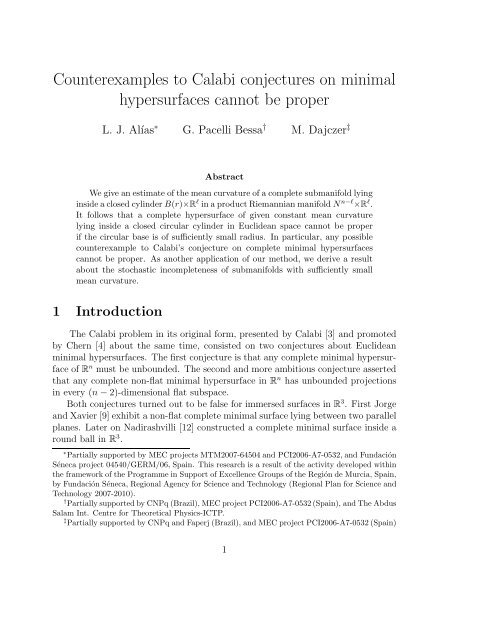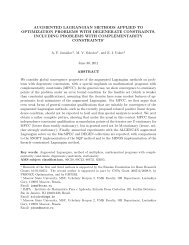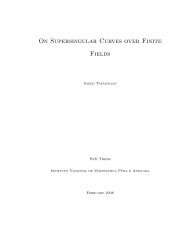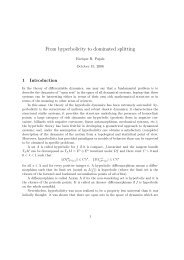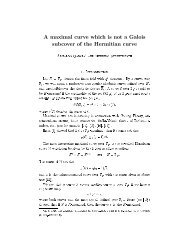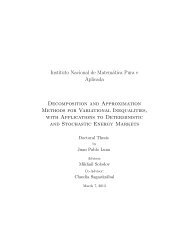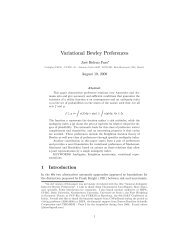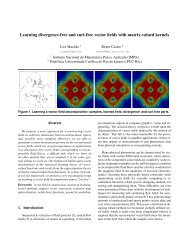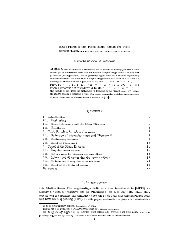Counterexamples to Calabi conjectures on minimal hypersurfaces ...
Counterexamples to Calabi conjectures on minimal hypersurfaces ...
Counterexamples to Calabi conjectures on minimal hypersurfaces ...
- No tags were found...
You also want an ePaper? Increase the reach of your titles
YUMPU automatically turns print PDFs into web optimized ePapers that Google loves.
<str<strong>on</strong>g>Counterexamples</str<strong>on</strong>g> <str<strong>on</strong>g>to</str<strong>on</strong>g> <str<strong>on</strong>g>Calabi</str<strong>on</strong>g> <str<strong>on</strong>g>c<strong>on</strong>jectures</str<strong>on</strong>g> <strong>on</strong> <strong>minimal</strong><strong>hypersurfaces</strong> cannot be properL. J. Alías ∗ G. Pacelli Bessa † M. Dajczer ‡AbstractWe give an estimate of the mean curvature of a complete submanifold lyinginside a closed cylinder B(r)×R l in a product Riemannian manifold N n−l ×R l .It follows that a complete hypersurface of given c<strong>on</strong>stant mean curvaturelying inside a closed circular cylinder in Euclidean space cannot be properif the circular base is of sufficiently small radius. In particular, any possiblecounterexample <str<strong>on</strong>g>to</str<strong>on</strong>g> <str<strong>on</strong>g>Calabi</str<strong>on</strong>g>’s c<strong>on</strong>jecture <strong>on</strong> complete <strong>minimal</strong> <strong>hypersurfaces</strong>cannot be proper. As another applicati<strong>on</strong> of our method, we derive a resultabout the s<str<strong>on</strong>g>to</str<strong>on</strong>g>chastic incompleteness of submanifolds with sufficiently smallmean curvature.1 Introducti<strong>on</strong>The <str<strong>on</strong>g>Calabi</str<strong>on</strong>g> problem in its original form, presented by <str<strong>on</strong>g>Calabi</str<strong>on</strong>g> [3] and promotedby Chern [4] about the same time, c<strong>on</strong>sisted <strong>on</strong> two <str<strong>on</strong>g>c<strong>on</strong>jectures</str<strong>on</strong>g> about Euclidean<strong>minimal</strong> <strong>hypersurfaces</strong>. The first c<strong>on</strong>jecture is that any complete <strong>minimal</strong> hypersurfaceof R n must be unbounded. The sec<strong>on</strong>d and more ambitious c<strong>on</strong>jecture assertedthat any complete n<strong>on</strong>-flat <strong>minimal</strong> hypersurface in R n has unbounded projecti<strong>on</strong>sin every (n − 2)-dimensi<strong>on</strong>al flat subspace.Both <str<strong>on</strong>g>c<strong>on</strong>jectures</str<strong>on</strong>g> turned out <str<strong>on</strong>g>to</str<strong>on</strong>g> be false for immersed surfaces in R 3 . First Jorgeand Xavier [9] exhibit a n<strong>on</strong>-flat complete <strong>minimal</strong> surface lying between two parallelplanes. Later <strong>on</strong> Nadirashvilli [12] c<strong>on</strong>structed a complete <strong>minimal</strong> surface inside around ball in R 3 .∗ Partially supported by MEC projects MTM2007-64504 and PCI2006-A7-0532, and FundaciónSéneca project 04540/GERM/06, Spain. This research is a result of the activity developed withinthe framework of the Programme in Support of Excellence Groups of the Región de Murcia, Spain,by Fundación Séneca, Regi<strong>on</strong>al Agency for Science and Technology (Regi<strong>on</strong>al Plan for Science andTechnology 2007-2010).† Partially supported by CNPq (Brazil), MEC project PCI2006-A7-0532(Spain), and The AbdusSalam Int. Centre for Theoretical Physics-ICTP.‡ Partially supported by CNPq and Faperj (Brazil), and MEC project PCI2006-A7-0532 (Spain)1
It was recently shown by Colding and Minicozzi [5] that both <str<strong>on</strong>g>c<strong>on</strong>jectures</str<strong>on</strong>g> holdfor embedded <strong>minimal</strong> surfaces. Their work involves the close relati<strong>on</strong> betweenthe <str<strong>on</strong>g>Calabi</str<strong>on</strong>g> <str<strong>on</strong>g>c<strong>on</strong>jectures</str<strong>on</strong>g> and properness. Recall that an immersed submanifold inEuclidean space is proper if the pre-image of any compact subset of R n is compact.It is a c<strong>on</strong>sequence of their general result that a complete embedded <strong>minimal</strong> diskin R 3 must be proper.The immersed counterexamples <str<strong>on</strong>g>to</str<strong>on</strong>g> <str<strong>on</strong>g>Calabi</str<strong>on</strong>g>’s <str<strong>on</strong>g>c<strong>on</strong>jectures</str<strong>on</strong>g> discussed above are notproper. The example of Nadirashvilli cannot be proper since from the definiti<strong>on</strong> aproper submanifold must be unbounded. The same c<strong>on</strong>clusi<strong>on</strong> hold for the otherexample but now the argument is not so easy, <strong>on</strong>e has <str<strong>on</strong>g>to</str<strong>on</strong>g> use the str<strong>on</strong>g half-spacetheorem due <str<strong>on</strong>g>to</str<strong>on</strong>g> Hoffman and Meeks [7].The str<strong>on</strong>g half-space theorem does not hold in R n for n ≥ 4. In fact, the higherdimensi<strong>on</strong>al catenoids are between parallel hyperplanes. Hence, it is natural <str<strong>on</strong>g>to</str<strong>on</strong>g> askif any possible higher dimensi<strong>on</strong>al counterexample <str<strong>on</strong>g>to</str<strong>on</strong>g> <str<strong>on</strong>g>Calabi</str<strong>on</strong>g>’s sec<strong>on</strong>d c<strong>on</strong>jecturemust be n<strong>on</strong>-proper. In the special case of <strong>minimal</strong> immersi<strong>on</strong>, it follows from thecorollary of our main result that a complete hypersurface of R n , n ≥ 3, with boundedprojecti<strong>on</strong> in a two dimensi<strong>on</strong>al flat subspace cannot be proper (see Corollary 2.2below).As an applicati<strong>on</strong> of our method, we generalize the results by Markvorsen [10] andBessa and M<strong>on</strong>tenegro [2] about s<str<strong>on</strong>g>to</str<strong>on</strong>g>chastic incompleteness of <strong>minimal</strong> submanifolds<str<strong>on</strong>g>to</str<strong>on</strong>g> submanifolds of bounded mean curvature. In this respect, let us recall thata Riemannian manifold M is said <str<strong>on</strong>g>to</str<strong>on</strong>g> be s<str<strong>on</strong>g>to</str<strong>on</strong>g>chastically complete if for some (andtherefore, for any) (x, t) ∈ M × (0, +∞) it holds that∫p(x, y, t)dy = 1,Mwhere p(x, y, t) is the heat kernel of the Laplacian opera<str<strong>on</strong>g>to</str<strong>on</strong>g>r. Otherwise, the manifoldM is said <str<strong>on</strong>g>to</str<strong>on</strong>g> be s<str<strong>on</strong>g>to</str<strong>on</strong>g>chastically incomplete (for further details about this see, forinstance, [6] or [14]).An interesting problem in submanifold geometry is <str<strong>on</strong>g>to</str<strong>on</strong>g> understand s<str<strong>on</strong>g>to</str<strong>on</strong>g>chasticcompleteness/incompleteness of submanifolds in terms of their extrinsic geometry.In [10] Markvorsen derived a mean time exit comparis<strong>on</strong> theorem which impliesthat any bounded complete <strong>minimal</strong> submanifold of a Hadamard manifold N withsecti<strong>on</strong>al curvature K N ≤ b ≤ 0 is s<str<strong>on</strong>g>to</str<strong>on</strong>g>chastically incomplete. Recently, Bessa andM<strong>on</strong>tenegro [2] c<strong>on</strong>sidered <strong>minimal</strong> submanifolds of product spaces N × R, whereN is a Hadamard manifold with K N ≤ b ≤ 0, and proved a versi<strong>on</strong> of Markvorsen’sresult in this setting. In particular, they showed that complete cylindrically bounded<strong>minimal</strong> submanifolds of N ×R are s<str<strong>on</strong>g>to</str<strong>on</strong>g>chastically incomplete. Here we extend theseresults <str<strong>on</strong>g>to</str<strong>on</strong>g> complete submanifolds with sufficiently small mean curvature lying insidea closed cylinder B(r) × R l in a product Riemannian manifold N n−l × R l .2
2 The resultsPart (a) of Theorem 2.1 below extends the main results given in [1] for compact<strong>hypersurfaces</strong>. Part (b) generalizes s<str<strong>on</strong>g>to</str<strong>on</strong>g>chastic incompleteness results of [2] and [10]for <strong>minimal</strong> submanifolds.In the following we denote⎧ √ √ √⎨ b cot( bt) if b > 0, t < π/2 b,C b (t) = 1/t if b = 0,⎩ √ √−b coth( −b t) if b < 0.Theorem 2.1 Let ϕ: M m → N n−l × R l be an isometric immersi<strong>on</strong> of a completeRiemannian manifold M of dimensi<strong>on</strong> m ≥ l + 1. Let B N (r) be the geodesic ballof N n−l centered at p with radius r. Given q ∈ M, assume that the radial secti<strong>on</strong>alcurvature K radNbounded as K radNal<strong>on</strong>g the radial geodesics issuing from p = π N(ϕ(q)) ∈ N n−l is≤ b in B N(r). Suppose thatϕ(M) ⊂ B N (r) × R lfor r < min{inj N (p), π/2 √ b}, where we replace π/2 √ b by +∞ if b ≤ 0.(a) If ϕ: M m → N n−l × R l is proper, then(b) Ifthen M is s<str<strong>on</strong>g>to</str<strong>on</strong>g>chastically incomplete.(m − l)sup |H| ≥M m C b(r). (1)(m − l)sup |H|
3 The proofsLet ϕ: M m → N n be an isometric immersi<strong>on</strong> between Riemannian manifolds. Givena functi<strong>on</strong> g ∈ C ∞ (N) we set f = g ◦ ϕ ∈ C ∞ (M). Sincefor every vec<str<strong>on</strong>g>to</str<strong>on</strong>g>r field X ∈ TM, we obtain〈grad M f, X〉 = 〈grad N g, X〉grad N g = grad M f + (grad N g) ⊥according <str<strong>on</strong>g>to</str<strong>on</strong>g> the decompositi<strong>on</strong> TN = TM ⊕T ⊥ M. An easy computati<strong>on</strong> using theGauss formula gives the well-known relati<strong>on</strong> (see e.g. [8])Hess M f(X, Y ) = Hess N g(X, Y ) + 〈grad N g, α(X, Y )〉 (3)for all vec<str<strong>on</strong>g>to</str<strong>on</strong>g>r fields X, Y ∈ TM, where α stands for the sec<strong>on</strong>d fundamental form ofϕ. In particular, taking traces with respect <str<strong>on</strong>g>to</str<strong>on</strong>g> an orth<strong>on</strong>ormal frame {e 1 , . . .,e m }in TM yieldsm∑∆ M f = Hess N g(e i , e i ) + 〈grad N g, H〉. → (4)where → H= ∑ mi=1 α(e i, e i ).i=1The first main ingredient of our proofs is the Hessian comparis<strong>on</strong> theorem.Theorem 3.1 Let M m be a Riemannian manifold and x 0 , x 1 ∈ M be such that thereis a minimizing unit speed geodesic γ joining x 0 and x 1 and let ρ(x) = dist(x 0 , x)be the distance functi<strong>on</strong> <str<strong>on</strong>g>to</str<strong>on</strong>g> x 0 . Let K γ ≤ b be the radial secti<strong>on</strong>al curvatures of Mal<strong>on</strong>g γ. If b > 0 assume ρ(x 1 ) < π/2 √ b. Then, we have Hess ρ(x)(γ ′ , γ ′ ) = 0 andwhere X ∈ T x M is perpendicular <str<strong>on</strong>g>to</str<strong>on</strong>g> γ ′ (ρ(x)).Hess ρ(x)(X, X) ≥ C b (ρ(x))‖X‖ 2 (5)The sec<strong>on</strong>d main ingredient is the versi<strong>on</strong> proved by Pigola-Rigoli-Setti [14,Theorem 1.9] of the Omori-Yau maximum principle.Theorem 3.2 Let M m be a Riemannian manifold and assume that there exists an<strong>on</strong>-negative C 2 -functi<strong>on</strong> ψ satisfying the following requirements:ψ(x) → +∞as x → ∞∃ A > 0 such that |gradψ| ≤ A √ ψ off a compact set√∃ B > 0 such that ∆ψ ≤ B ψG( √ ψ) off a compact set4
where G is a smooth functi<strong>on</strong> <strong>on</strong> [0, +∞) satisfying:(i) G(0) > 0,(ii) G ′ (t) ≥ 0 <strong>on</strong> [0, +∞),(iii) 1/ √ G(t) ∉ L 1 (0, +∞), (iv) lim sup t→+∞tG( √ t)G(t)< +∞.(6)Then, given a functi<strong>on</strong> u ∈ C 2 (M) with u ∗ = sup M u < +∞ there exists a sequence{x k } k∈N ⊂ M m such thatu(x k ) > u ∗ − 1/k; |gradu|(x k ) < 1/k; ∆u(x k ) < 1/k.Observe that a functi<strong>on</strong> G satisfying the above c<strong>on</strong>diti<strong>on</strong>s isNow we are ready <str<strong>on</strong>g>to</str<strong>on</strong>g> prove Theorem 2.1.G(t) = (t + 2) 2 (log(t + 2)) 2 . (7)Proof of Theorem 2.1: Define σ : N n−l × R l → [0, +∞) byσ(z, y) = ρ R l(y),where ρ R l(y) = ‖y‖ R l is the distance functi<strong>on</strong> <str<strong>on</strong>g>to</str<strong>on</strong>g> the origin in R l . Since ϕ is properand ϕ(M) ⊂ B N (r) × R l , then the functi<strong>on</strong> ψ(x) = σ ◦ ϕ(x) satisfies ψ(x) → ∞ asρ M (x) = dist M (q, x) → +∞. Off a compact set, we now have|grad M ψ(x)| ≤ |grad N×Rl σ(ϕ(x))| = |grad Rl ρ R l| = 1 ≤ √ ψ(x).To compute ∆ M ψ we start with bases {∂/∂ρ N , ∂/∂θ 2 , . . .,∂/∂θ n−l } of TN and{∂/∂ρ R l, ∂/∂γ 2 , . . .,∂/∂γ l } of TR l (polar coordinates) orth<strong>on</strong>ormal at x ∈ M.Then, we choose an orth<strong>on</strong>ormal basis {e 1 , . . ., e m } for T x M as follows∂ ∑n−l∂ ∂e i = α i + a ij + β i∂ρ N ∂θ j ∂ρ R lj=2+l∑t=2b it∂∂γ t·Hence, we haveHess N×R l σ(ϕ(x))(e i , e i ) = Hess R l ρ R l(π R le i , π R le i ) =1σ(ϕ(x))where π R l denotes the orthog<strong>on</strong>al projecti<strong>on</strong> <strong>on</strong><str<strong>on</strong>g>to</str<strong>on</strong>g> TR l . Here, we are usingn−l|e i | = 1 = αi 2 + ∑l∑a 2 ij + β2 i +j=25t=2b 2 itl∑t=2b 2 it ≤ 1ψ(x) ,
that yields ∑ lt=2 b2 it ≤ 1.Since ψ(x) → ∞ as ρ M (x) = dist M (q, x) → +∞, off a compact set we mayassume that√| H|(x) → = m|H|(x) ≤ ψ(x)G( √ ψ(x))where G(t) is given by (7). Otherwise, sup M |H| = +∞ and there is nothing <str<strong>on</strong>g>to</str<strong>on</strong>g>prove. Besides, off a compact set we also have that√1ψ(x) ≤ ψ(x)G( √ ψ(x)).Hence, from (4) we have off a compact set that∆ M ψ(x) =m∑Hess N×R l σ(ϕ(x))(e i , e i ) + 〈grad N×Rl σ(ϕ(x)), H → (x)〉i=1≤mψ(x) + m|H|(x)√≤ (m + 1) ψ(x)G( √ ψ(x)).Therefore, by Theorem 3.2 the Omori-Yau maximum principle holds <strong>on</strong> M.Define ρ: N n−l × R l → R byand u: M m → R byρ(z, y) = ρ N (z) = dist N (p, z)u(x) = ρ ◦ ϕ(x).Since ϕ(M) ⊂ B N (r) × R l , we have that u ∗ = sup M u ≤ r < ∞, Therefore, by themaximum principle there is a sequence {x k } k∈N ⊂ M m such thatHence, we have1k > ∆u(x k) =u(x k ) > u ∗ − 1/k; |gradu|(x k ) < 1/k; ∆u(x k ) < 1/k.m∑Hess N×R lρ(ϕ(x k ))(e i , e i ) + 〈grad N×Rl ρ(ϕ(x k )), H → (x k )〉 (8)i=1where {e 1 , . . .,e m } is an orth<strong>on</strong>ormal basis for T xk M. Start with an orth<strong>on</strong>ormalbasis {∂/∂ρ N , ∂/∂θ 2 , . . .,∂/∂θ n−l } for TN and standard coordinates {y 1 , . . .y l } forR l . Then, choose an orth<strong>on</strong>ormal basis for T xk M as follows∂ ∑n−l∂e i = α i + a ij +∂ρ N ∂θ jj=26l∑t=1c it∂∂y t·
Using Theorem 3.1, a straightforward computati<strong>on</strong> yieldssinceHess N×R lρ(ϕ(x k ))(e i , e i ) = Hess N ρ N (z(x k ))(π TN e i , π TN e i )=≥=∑n−la 2 ijHess N ρ N (z(x k ))(∂/∂θ j , ∂/∂θ j )j=2∑n−la 2 ijC b (r) (9)j=2(1 − α 2 i −l∑t=1c 2 it)n−l|e i | = 1 = αi 2 + ∑ l∑a 2 ij + c 2 it ,j=2t=1C b (r)where π TN denotes the orthog<strong>on</strong>al projecti<strong>on</strong> <strong>on</strong><str<strong>on</strong>g>to</str<strong>on</strong>g> TN. Therefore,m∑Hess N×R lρ(ϕ(x k ))(e i , e i ) ≥i=1At x k , we haveand hence(m − ∑ iα 2 i − ∑ i,tgrad N×Rl ρ(ϕ(x k )) = gradu(x k ) + (grad N×Rl ρ(ϕ(x k ))) ⊥|gradu| 2 (x k ) =m∑i=1〈 ∂∂ρ N, e i 〉 = ∑ ic 2 it)C b (r). (10)α 2 i < 1/k2 . (11)Taking in<str<strong>on</strong>g>to</str<strong>on</strong>g> account |grad N×Rl ρ| = |grad N ρ N | = 1, from (8) and (10) we obtain1(k > m − ∑ iα 2 i − ∑ i,tc 2 it)C b (r) − m sup |H|.MIt follows using (11) that1k + C b(r)k 2(+ m sup |H| ≥ m − ∑Mi,tc 2 it)C b (r). (12)Observe now that∑c 2 it =i,tl∑ m∑c 2 it =t=1 i=1l∑|grad(y t ◦ ϕ)| 2 ≤ l,t=17
since |grad(y t ◦ ϕ)| 2 ≤ |grad Rl y t | 2 = 1. Thus,( )m − ∑ i,tc 2 it≥ (m − l)and we have letting k → +∞ in (12) thatm sup |H| ≥ (m − l)C b (r).MThis c<strong>on</strong>cludes the proof of the first part of Theorem 2.1.For the proof of the sec<strong>on</strong>d part, we make use of the following characterizati<strong>on</strong>of s<str<strong>on</strong>g>to</str<strong>on</strong>g>chastic completeness given in [13] (see [14, Theorem 3.1]): A Riemannianmanifold M is s<str<strong>on</strong>g>to</str<strong>on</strong>g>chastically complete if and <strong>on</strong>ly if for every u ∈ C 2 (M) withu ∗ = sup u < ∞ there exists a sequence {x k } such that u(x k ) > u ∗ − 1/k and∆u(x k ) < 1/k for every k ≥ 1.whereSuppose that M is s<str<strong>on</strong>g>to</str<strong>on</strong>g>chastically complete. Define g: N n−l × R l → R byg(z, y) = ĝ(z) = φ b (ρ N (z))⎧⎨ 1 − cos( √ bt) if b > 0, t < π/2 √ b,φ b (t) = t 2 if b = 0,⎩cosh( √ −bt) if b < 0.Then f = g ◦ ϕ is a smooth bounded functi<strong>on</strong> <strong>on</strong> M. Thus there exists a sequenceof points {x k } in M such thatf(x k ) > f ∗ − 1/k and ∆f(x k ) < 1/kfor k ≥ 1, where f ∗ = sup M f ≤ φ b (r) < ∞. Similar as before, we haveHess N×R lg(ϕ(x k ))(e i , e i ) = Hess N ĝ(z(x k ))(π TN e i , π TN e i )∑n−l= φ ′′b(r k )αi 2 + φ ′ b(r k ) a 2 ijHess N ρ N (z(x k ))(∂/∂θ j , ∂/∂θ j )j=2∑n−l≥ φ ′′b(r k )αi 2 + φ ′ b(r k )C b (r k )= φ ′′b(r k )α 2 i + φ ′ b(r k )C b (r k )= φ ′ b (r k)C b (r k )(81 −l∑t=1c 2 itj=2()a 2 ij1 − α 2 i −l∑t=1c 2 it)
m − ∑ i,tsince φ ′′b (t) − φ′ b (t)C b(t) = 0. Here, we are writing r k = ρ N (z(x k )). Therefore,1k > ∆f(x k) =m∑Hess N×R lg(e i , e i ) + 〈grad N×Rl g, H〉→i=1( )≥ φ ′ b (r k)C b (r k )c 2 it+ φ ′ b (r k)〈grad N×Rl ρ N , → H〉≥ φ ′ b (r k) ((m − l)C b (r k ) − m sup |H|).Finally, since lim k→∞ φ ′ b (r k) > 0, letting k → ∞ we havesup |H| ≥(m − l)mC b(r).Proof of Corollary 2.2: If ϕ is proper in R n+1 , from part (a) of Theorem 2.1 wewould have |H| ≥ 1/nr, and that is a c<strong>on</strong>tradicti<strong>on</strong>.References[1] G. P. Bessa and J. F. M<strong>on</strong>tenegro, On compact H-Hypersurfaces of N × R.Geom. Dedicata. 127 (2007), 1–5.[2] G. P. Bessa J. Fabio M<strong>on</strong>tenegro, Mean time exit and isoperimetric inequalitiesfor <strong>minimal</strong> submanifolds of N × R. To appear in Bull. L<strong>on</strong>d<strong>on</strong> Math.Soc. Available at http://arxiv.org/pdf/0709.1331[3] E. <str<strong>on</strong>g>Calabi</str<strong>on</strong>g>, Problems in Differential Geometry (S. Kobayashi and J. Eells, Jr.,eds.) Proc. of the United States-Japan Seminar in Differential Geometry,Kyo<str<strong>on</strong>g>to</str<strong>on</strong>g>, Japan, 1965, Nipp<strong>on</strong> Hyor<strong>on</strong>sha Co. Ltd., Tokyo (1966) 170.[4] S. S. Chern, The Geometry of G-structures. Bull. Amer. Math. Soc. 72(1966), 167–219.[5] T. Colding and W. Minicozzi II, The <str<strong>on</strong>g>Calabi</str<strong>on</strong>g>-Yau <str<strong>on</strong>g>c<strong>on</strong>jectures</str<strong>on</strong>g> for embeddedsurfaces. Annals of Math. 161 (2005) 727–758.[6] A. Grigor’yan, Analytic and geometric background of recurrence and n<strong>on</strong>explosi<strong>on</strong>of the Brownian moti<strong>on</strong> <strong>on</strong> Riemannian manifolds, Bull. Amer.Math. Soc. (N.S.) 36 (1999), 135–249.[7] D. Hoffman and W. Meeks, The Str<strong>on</strong>g Half-space Theorem for <strong>minimal</strong>surfaces. Invent. Math. 101 (1990) 373–377.[8] L. Jorge and D. Koutrofiotis, An estimate for the curvature of bounded submanifolds.Amer. J. Math. 103 (1980) 711–725.9
[9] L. Jorge and F. Xavier, A complete <strong>minimal</strong> surface in R 3 between two parallelplanes. Ann. of Math. 112 (1980) 203–206.[10] S. Markvorsen, On the mean exit time from a submanifol. J. DifferentialGeom. 29 (1989), 1-8.[11] F. Martín and S. Morales, A complete bounded <strong>minimal</strong> cylinder in R 3 .Michigan Math. J. 47 (2000), 499–514.[12] N. Nadirashvili, Hadamard’s and <str<strong>on</strong>g>Calabi</str<strong>on</strong>g>-Yau’s <str<strong>on</strong>g>c<strong>on</strong>jectures</str<strong>on</strong>g> <strong>on</strong> negativelycurved and <strong>minimal</strong> surfaces. Invent. Math. 126 (1996), 457–465.[13] S. Pigola, M. Rigoli and A. Setti, A remark <strong>on</strong> the maximum principle ands<str<strong>on</strong>g>to</str<strong>on</strong>g>chastic completeness. Proc. Amer. Math. Soc. 131 (2003), 1283–1288.[14] S. Pigola, M. Rigoli and A. Setti, Maximum Principle <strong>on</strong> Riemannian Manifoldsans Applicati<strong>on</strong>s. Memoirs Amer. Math. Soc. 822 (2005).Luis J. AliasDepartamen<str<strong>on</strong>g>to</str<strong>on</strong>g> de MatematicasUniversidad de MurciaCampus de Espinardo E-30100 – Spainljalias@um.esGregorio Pacelli BessaUFC - Departamen<str<strong>on</strong>g>to</str<strong>on</strong>g> de MatematicaBloco 914 – Campus do Pici60455-760 – Fortaleza – Ceara – Brazilbessa@mat.ufc.brMarcos DajczerIMPAEstrada D<strong>on</strong>a Cas<str<strong>on</strong>g>to</str<strong>on</strong>g>rina, 11022460-320 – Rio de Janeiro – Brazilmarcos@impa.br10


